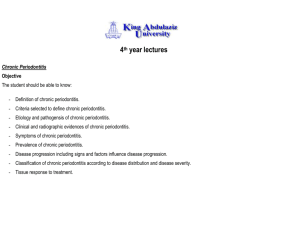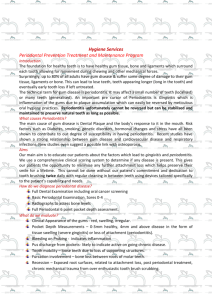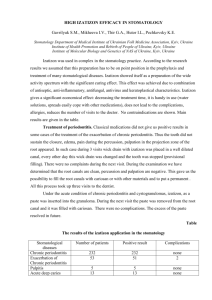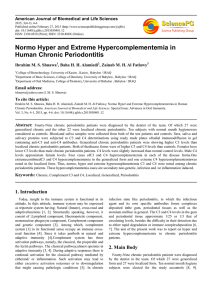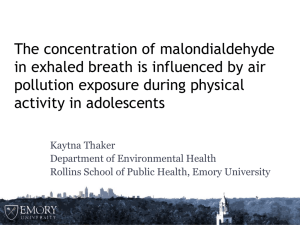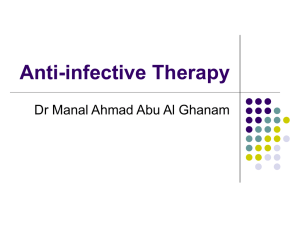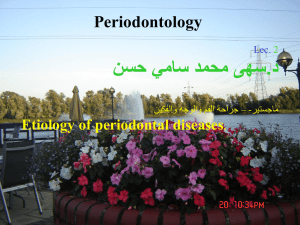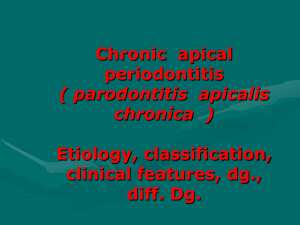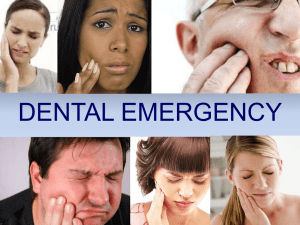INTRODUCTION Periodontitis, a chronic disease is characterized by
advertisement
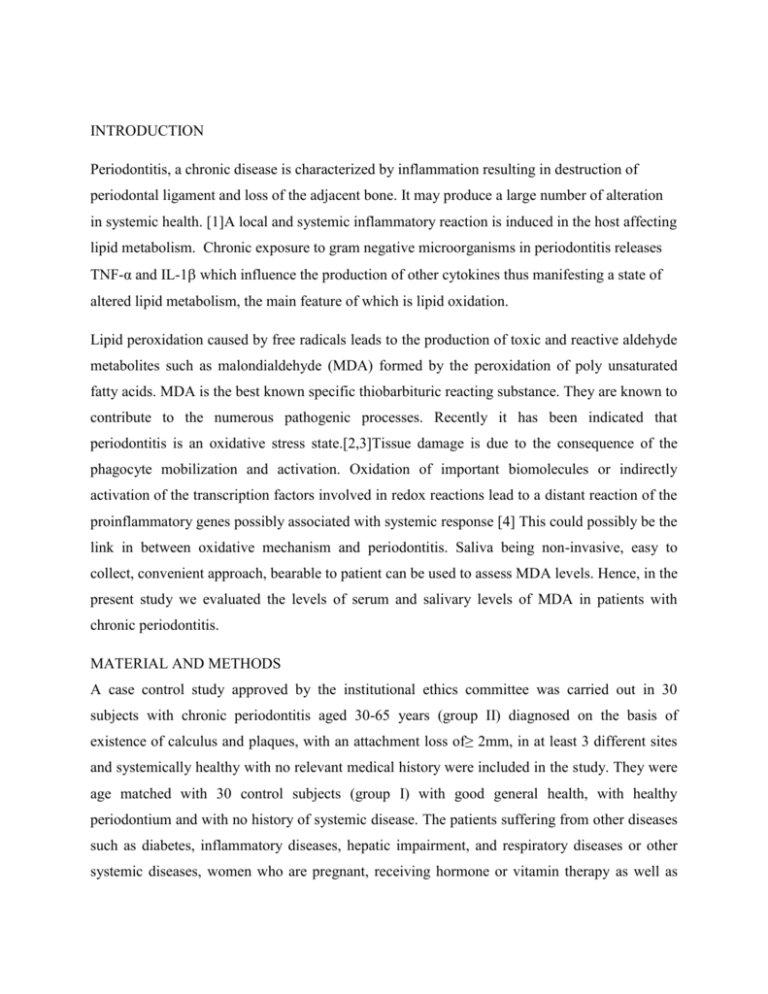
INTRODUCTION Periodontitis, a chronic disease is characterized by inflammation resulting in destruction of periodontal ligament and loss of the adjacent bone. It may produce a large number of alteration in systemic health. [1]A local and systemic inflammatory reaction is induced in the host affecting lipid metabolism. Chronic exposure to gram negative microorganisms in periodontitis releases TNF-α and IL-1 which influence the production of other cytokines thus manifesting a state of altered lipid metabolism, the main feature of which is lipid oxidation. Lipid peroxidation caused by free radicals leads to the production of toxic and reactive aldehyde metabolites such as malondialdehyde (MDA) formed by the peroxidation of poly unsaturated fatty acids. MDA is the best known specific thiobarbituric reacting substance. They are known to contribute to the numerous pathogenic processes. Recently it has been indicated that periodontitis is an oxidative stress state.[2,3]Tissue damage is due to the consequence of the phagocyte mobilization and activation. Oxidation of important biomolecules or indirectly activation of the transcription factors involved in redox reactions lead to a distant reaction of the proinflammatory genes possibly associated with systemic response [4] This could possibly be the link in between oxidative mechanism and periodontitis. Saliva being non-invasive, easy to collect, convenient approach, bearable to patient can be used to assess MDA levels. Hence, in the present study we evaluated the levels of serum and salivary levels of MDA in patients with chronic periodontitis. MATERIAL AND METHODS A case control study approved by the institutional ethics committee was carried out in 30 subjects with chronic periodontitis aged 30-65 years (group II) diagnosed on the basis of existence of calculus and plaques, with an attachment loss of≥ 2mm, in at least 3 different sites and systemically healthy with no relevant medical history were included in the study. They were age matched with 30 control subjects (group I) with good general health, with healthy periodontium and with no history of systemic disease. The patients suffering from other diseases such as diabetes, inflammatory diseases, hepatic impairment, and respiratory diseases or other systemic diseases, women who are pregnant, receiving hormone or vitamin therapy as well as smokers and alcoholics, were excluded from the study. Informed consent was obtained from each participant in the study. 5 ml of venous blood samples and unstimulated whole saliva samples was collected in plain bulbs from patients with periodontitis and normal healthy individuals. Samples were centrifuged at 3000g for 10 minutes and supernatant stored at -20oC until analysis. Malondialdehyde (MDA), a marker of the oxidant status was determined by method of randox laboratory. This method was based on the fact that lipid peroxide condense with 1 methyl-2 phenyl indole (MPI) under acidic conditions resulting in the formation of a red chromophore. To determine specifically lipid peroxide in plasma, proteins are precipitated to remove water-soluble MPI reactive substance. The level of lipid peroxide is expressed in terms of malondialdehyde, which is unstable. Tetramethoxypropane, which is converted quantitatively to MDA in the reaction procedure, is used as standard. Statistical analysis of difference was estimated using students `t` test. RESULTS AND DISCUSSION Lipid peroxidation, a free radical- induced mechanism has been implicated in the pathogenesis of several disorders including periodontal disease. Periodontal disease are known to be associated with an imbalance between the oxidants and antioxidants, i.e due to an increase in the free radical production and a defect in the total antioxidant activity of the saliva.[5] Our results reveal that MDA levels are significantly increased in the periodontal pocket/ oral environment. Dhotre PS [6] and Khalili J [7] also revealed increased levels of MDA in saliva in periodontitis.Porphyromonas gingivalis, treponema denticola and bacteroides forsythus are the key causative bacteria for periodontitis. These have special enzymes and proteins that enable them to trigger host inflammation. Oxidative burst during phagocytosis by the neutrophils may be implicated as one of the factors responsible for periodontitis. This reactive oxygen species generation may be responsible for the bone resorption, degradation of connective tissue and increase in the matrix metalloproteinase activity [8] The polymorphonuclear leukocytes are the initial and the predominant defence cells produced during the host response to bacterial pathogens. The periodontopathogens along with their products induce the generation of free radicals. The over production of MDA at the inflammatory site can be related to the greater degree of oxidative stress in patients with periodontitis. Reactive oxygen species have been implicated in the destruction of the peridontium during inflammatory periodontal diseases in absence of suitable antioxidants in the crevicular space. ROS are able to produce chemical modifications and to damage proteins, lipids, carbohydrate and nucleotide in the tissues and damage cells by initiation of the lipid peroxidation causing profound alteration in the structural integrity and functions of cell membrane.[9] In our study there is no significant difference in the serum MDA levels. This is in concurrence with the study of Akalin FA [4]. However Dhotre PS [6] and Rai B[10] reported significantly higher levels of serum MDA in patients with periodontitis. These increase in the levels of MDA were referred to the possibility of an association between periodontitis and cardiovascular disease. Insufficient antioxidant potential could be responsible for the increase in the levels of MDA in these studies. Thus further studies of large populations should be investigated so as to detect salivary and serum MDA level in the elucidation of the pathogenesis and to clarify the importance in periodontal disease. Moreover, modalities of antioxidant supplementation in prevention and treatment of periodontitis should be evaluated. REFERENCES 1. Otomo-Corgel J. Merin RL. Periodontal disease and systemic health-what you and your patients need to know. J Calif Dent Assoc 2002;30:307-311. 2. Kuppuswamy P, Shanmugam M, Cinnamanoor R. Lipid peroxidation and antioxidant status in patients with periodontitis. Cell Mol Biol Lett 2005;10(2):255-254. 3. Tsai CC, Chen HS, Chen SL, Ho YP, Wu YM et al. Lipid peroxidation: A possible role in the induction and progression of chronic periodontitis. J Periodontal Res 2005 Oct 40(5): 378-384. 4. Akalin FA, Baltacioglu E, Alver A, Karabulut E. Lipid peroxidation levels and total oxidant status in serum, saliva and gingival crevicular fluid in patients with chronic periodontitis. J Clin Periodontol 2007;34:558-565. 5. Zaidan TF. The role of lipid peroxidation in the induction and progression of chronic periodontitis. J Bagh Coll Dentistry 2009 vol21(1):70-73. 6. Dhotre PS, Suryakar AN, Bhogade RB. Oxidative stress in periodontitis: A critical link to cardiovascular disease. Biomedical Res 2011;22(2):178-182. 7. Khalili J, Biloklytska HF. Salivary malondialdehyde levels in clinically healthy and periodontal diseased individuals. Oral Dis 2008 Nov.14( 8): 754-60. 8. Pendyala G, Thomas B, Suchetha K. The challenge of antioxidants to free radicals in periodontitis. J Ind Soc Periodontology 2008 Sep-Dec;12(3):79-83. 9. De Zwart LL, Meerman JHN, Commandeur JNM et al. Biomarkers of free radical damage applications in experimental animals and humans.Free Radic Biol and Med. 1999;26;202-26. 10. Rai B, Kharb S, Jain R and Anand SC. Salivary lipid peroxidation product malondialdehyde in various dental diseases. World J Med Sci 2006;1(2):100-101] TABLE I Levels of serum and salivary MDA in patients with chronic periodontitis Group I(n=30) Group II(n=30) Normal controls Patients with chronic periodontitis Serum MDA (nmol/litre) 1.18 ± 0.28 1.75 ± 0.35 Salivary MDA (nmol/litre) 1.17 ± 0.27 3.39 ± 0.54* *p<0.001 when group II compared with group I.
